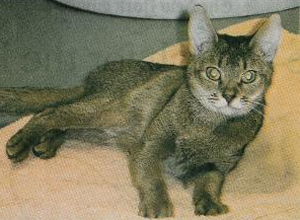UCSD Researcher Participates in Sequencing of Domestic Cat Genome
San Diego, CA, November 9, 2007 -- A report in the current issue of the journal Genome Research details the first assembly, annotation, and comparative analysis of the domestic cat genome (Felis catus ). Co-authors of the multi-institutional study include Glenn Tesler, an assistant professor in UCSD's Department of Mathematics and Bioinformatics Program, and a founding member of the Center for Algorithmic and Systems Biology (CASB), a center based in the UCSD Division of the California Institute for Telecommunications and Information Technology (Calit2).
|
The DNA of a four-year-old Abyssinian cat named Cinnamon, whose well-documented lineage can be traced back several generations to Sweden, was sequenced. Cinnamon is one of several mammals that are currently being analyzed using "light" (two-fold) genome sequence coverage. To make sense of Cinnamon's raw sequence data, scientists leveraged information from previously sequenced mammalian genomes as well as previous gene-mapping studies in the cat. In doing so, they found that Cinnamon's sequences spanned about 65% of the euchromatic (gene-containing) regions of the feline genome.
The similarity between the cat genome and six recently completed mammalian genomes (human, chimpanzee, mouse, rat, dog, and cow) allowed the scientists to identify 20,285 putative genes in the cat genome. The comparison also revealed hundreds of chromosomal rearrangements that have occurred among the different lineages of mammals since they diverged from a diminutive ancestor that roamed the earth among the dinosaurs approximately 94 million years ago.
|
The findings on chromosomal rearrangements were contributed to the study by UCSD's Tesler and Guillaume Bourque of the Genome Institute of Singapore. Focusing on evolutionary implications, Tesler and Bourque compared genome rearrangements -- changes in gene orders -- between the cat genome and five mammalian genomes that have been sequenced at deep-coverage: dog, mouse, rat, chimpanzee, and human. They compared the chromosomal locations of over 90,000 corresponding DNA features between the genomes to study how they were shuffled since divergence from their common ancestor, and split them into 339 large-scale regions.
Evolutionary rearrangements are rare events that occur approximately once every million years, and lead to speciation. Earlier studies have shown that shuffling between different chromosomes occurs slowly in most lineages (including cat and primates) but much faster in other lineages (including dog and rodents).
However, the earlier studies were insensitive to shuffling within the same chromosome. Comparison of sequenced DNA allows for detection of shuffling both between chromosomes and within chromosomes. In the study published in Genome Research, Tesler and Bourque show that in the "slowly evolving" cat and primate lineages, the rate of shuffling within chromosomes is much higher than the rate of shuffling between chromosomes. "This suggests that while the chromosomal organization of the 'slowly evolving' genomes is still closer to the common ancestor than the 'fast evolving' genomes, the overall number of rearrangements on the slowly-evolving lineages is greater than previously thought," explained Tesler, whose work was funded by a Sloan Research Fellowship in Molecular Biology. "The current cat genome sequence covers approximately 65 percent of the feline genome, so these measurements will be reconsidered in the future after deep-coverage sequencing is done of the cat genome."
The genome sequence analysis is expected to lead to health benefits for domestic cats, 90 million of which are owned by Americans alone, according to The Humane Society. But the domestic cat also serves as an excellent model for human disease, which is one reason why the National Human Genome Research Institute (NHGRI) initially authorized the cat genome sequencing project three years ago.
Domestic cats possess over 250 naturally occurring hereditary disorders, many of which are similar to genetic pathologies in humans. For example, Cinnamon's pedigree carries a genetic mutation that causes retinitis pigmentosa, a degenerative eye disease that can lead to blindness. In humans, retinitis pigmentosa affects 1 in 3,500 Americans. The domestic cat also serves as an excellent model for human infectious diseases. Feline immunodeficiency virus (FIV) is a genetic relative of the human immunodeficiency virus (HIV), which causes AIDS.
Using the cat genome sequence data, other researchers identified several hundred thousand genomic variants which can be used to determine the genetic basis for common hereditary diseases. The variants will also be useful for parentage testing, forensic analysis, and studies of evolution, including the reconstruction of domestication processes, fancy breed development, and ecological adaptation among the great roaring cats.
The researchers also analyzed the feline genome for interesting features such as microRNAs, Numts (pronounced "new mights"-nuclear genomic fragments that migrated to cat chromosomes from mitochondria), and a vast sea of selfish DNA-like repetitive elements. The repetitive elements included scores of genomic stretches from historic retroviruses, some with known links to cancer.
The Cat Genome Project is based at the National Cancer Institute (NCI) in Frederick, MD. Cinnamon lives in a cat colony maintained at the University of Missouri-Columbia. The sequencing data were generated by Beverly, MA-based Agencourt Bioscience Corporation.
Full citation
Pontius, J.U., Mullikin, J.C., Smith, D., Agencourt Sequencing Team, Lindblad-Toh, K., Gnerre, S., Clamp, M., Chang, J., Stephens, R., Neelam, B., Volfovsky, N., Schäffer, A.A., Agarwala, R., Narfström, K., Murphy, W.J., Giger, U., Roca, A.L., Antunes, A., Menotti-Raymond, M., Yuhki, N., Pecon-Slattery, J., Johnson, W.E., Bourque, G., Tesler, G., NISC Comparative Sequencing Program, O'Brien, S.J. 2007. Initial sequence and comparative analysis of the cat genome. Genome Res. 17: 1675-1689. [doi:10.1101/gr.6380007]
[Full article] http://www.genome.org/cgi/reprint/17/11/1675
[Abstract] http://www.genome.org/cgi/content/abstract/17/11/1675
Related Links
Genome Research
Media Contacts
Media Contact: Doug Ramsey, 858-822-5825, dramsey@ucsd.edu



